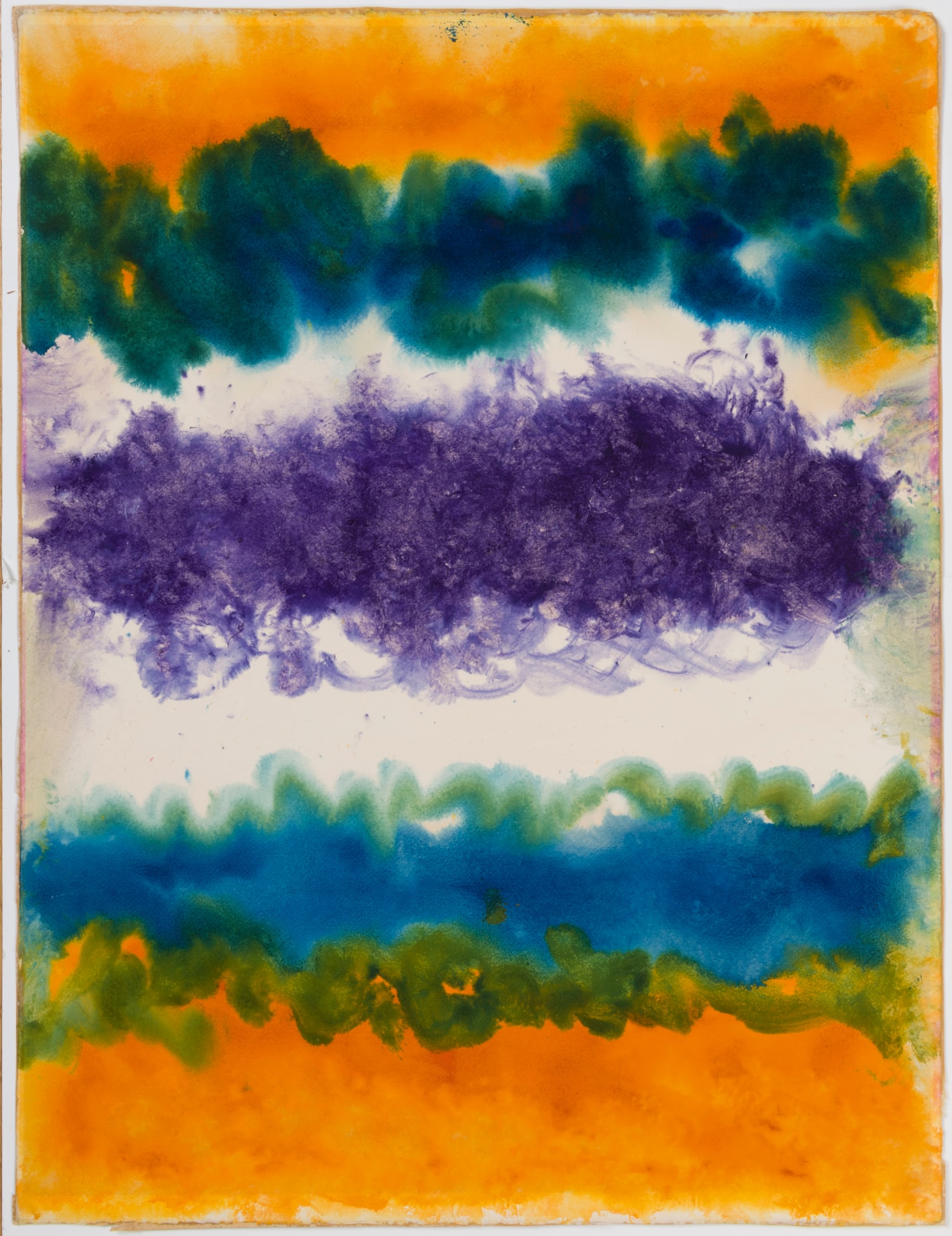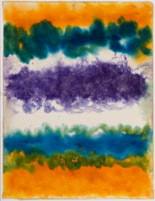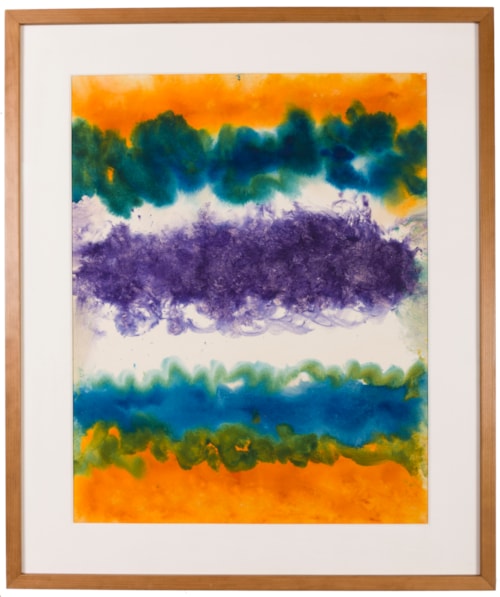Beauford DELANEY
(Knoxville 1901 - Paris 1979)
Untitled, 1961
Sold
Watercolour and gouache on paper.
Signed and dated Beauford Delaney 61 / San Telmo Mallorca at the lower right.
Further inscribed and dated Beaufort Delaney / 1961 / Mallorca on a label pasted onto the old backing board.
657 x 500 mm. (25 7/8 x 19 5/8 in.) [sheet]
Signed and dated Beauford Delaney 61 / San Telmo Mallorca at the lower right.
Further inscribed and dated Beaufort Delaney / 1961 / Mallorca on a label pasted onto the old backing board.
657 x 500 mm. (25 7/8 x 19 5/8 in.) [sheet]
This large sheet was drawn on the island of Majorca in August 1961, shortly after a trip to Greece when Delaney suffered a severe mental breakdown, believing that a mob was trying to kill him, and had attempted suicide. Accompanied by some friends from Paris - Charley Boggs, a painter from West Virginia, and his wife Gita, their young son Gordon, and Joe and Bernice O’Reilly - the artist had gone to the coastal village of San Telmo in Majorca to try and recover his health. His mental state remained very poor, however, and he continued to hear voices that led him to believe that criminals had followed him from Greece and were intent on doing him harm. Nevertheless, as Delaney’s biographer David Leeming notes, ‘In San Telmo he did eat well and rest, and, with the help of soothing talks with Bernice and Gita especially, managed to maintain a surface calm and even began to do some watercolors.’ As the artist himself wrote in a letter from San Telmo to a friend, ‘Being here has calmed me much. Eat well and make watercolors and feel my old self.’
Leeming has written that ‘There is one brief period in his life during which Beauford’s paintings do seem to be a direct representation of his psychological problems. On his way to Greece in 1961, Beauford attempted suicide. After his return to Paris, he went with friends to Majorca in search of restoration, and later in 1962, he spent time in a mental hospital. During these months, Beauford did several works in watercolor and gouache on paper. He spoke of these works, executed quickly with wide brush strokes, as his “Rorschach tests”, and some of them were, in fact, done at his doctor’s suggestion…After his release from hospital and removal to the Rue Vercingétorix, Beauford wrote to his old friend Henry Miller that the “birth pains” associated with his passage from sickness to “enlightenment” were “almost unbearable…yet morning comes after the darkest night.”…The watercolor and gouache paintings on paper of the early sixties are liquid in feeling – green and blue pools serving as breeding sources for Beauford’s motion-filled and all-pervasive yellow light.’ Only a handful of works by Delaney done during his brief stay in Majorca are known.
Leeming has written that ‘There is one brief period in his life during which Beauford’s paintings do seem to be a direct representation of his psychological problems. On his way to Greece in 1961, Beauford attempted suicide. After his return to Paris, he went with friends to Majorca in search of restoration, and later in 1962, he spent time in a mental hospital. During these months, Beauford did several works in watercolor and gouache on paper. He spoke of these works, executed quickly with wide brush strokes, as his “Rorschach tests”, and some of them were, in fact, done at his doctor’s suggestion…After his release from hospital and removal to the Rue Vercingétorix, Beauford wrote to his old friend Henry Miller that the “birth pains” associated with his passage from sickness to “enlightenment” were “almost unbearable…yet morning comes after the darkest night.”…The watercolor and gouache paintings on paper of the early sixties are liquid in feeling – green and blue pools serving as breeding sources for Beauford’s motion-filled and all-pervasive yellow light.’ Only a handful of works by Delaney done during his brief stay in Majorca are known.
One of the leading Black artists of the Harlem Renaissance, Beauford Delaney was norn in Tennessee, the eighth of ten children, and was recognized as a skilled draughtsman from an early age. He studied first in Boston and then in New York, settling in Harlem in 1929 and later setting up a studio in Greenwich Village. He soon established a reputation as a fine portraitist in pastel, particularly of such notable Black figures as Louis Armstrong, W. E. B. DuBois, Duke Ellington and W. C. Handy. In 1930 Delaney had his first small one-man show at a Harlem branch of the New York Public Library, showing five pastels and ten drawings, and further solo shows followed in 1938 and 1941. A photograph of the artist surrounded by his paintings during the annual outdoor exhibition in Washington Square Park appeared in Life magazine in October 1938 and first brought his work to the attention of an audience beyond New York. In Greenwich Village in 1940 Delaney met the young Black writer James Baldwin, to whom he became something of a mentor, and who was to be a lifelong friend and champion. Delaney and Baldwin shared an apartment for a while, and Baldwin often sat for the artist. Delaney was also the subject of a laudatory essay by Henry James, entitled The Amazing and Invariable Beauford DeLaney [sic], published as a chapbook in 1945. A one-man show at the Artist’s Gallery in New York in 1947 was followed by shows at the Roko Gallery between 1949 and 1953, while Delaney also spent one summer on a fellowship at the Yaddo Estate writer’s and artist’s colony in upstate New York.
In 1953, at the age of fifty-two, Delaney settled in Paris, where he was soon reacquainted with Baldwin, who had moved to France in 1948 and was on the brink of fame. Living for a few years in Montparnasse, Delaney eventually settled in the Parisian suburb of Clamart. His work underwent a transformation in Paris, from the figurative subjects of his New York period to a greater interest in abstract compositions expressed through colour and light. A large exhibition of his work was held at the Galerie Paul Fachetti in 1960, which was a critical but not commercial success, and the following year he took part in a group show at the Centre Culturel Américain in Paris. There he met Darthea Speyer, the cultural attaché at the American Embassy in Paris and later a gallerist, who became a very close friend, patron and supporter. Delaney continued to struggle financially, however, and by 1961 his alcoholism was affecting his psychological state. He began experiencing periods of manic behaviour and mental illness, often accompanied by paranoid delusions, although painting and listening to music often helped him to remain a semblance of calm. Following a nervous collapse while on holiday in Greece in 1961, however, he spent a long period of time in a clinic in Nogent-sur-Marne. Following his release, he moved from Clamart to a studio - paid for by friends - on the Rue Vercingétorix in Paris, where he began to work productively again, producing a fine body of work that was shown in an exhibition at the Galerie Lambert in 1964. (The catalogue of the exhibition included commentaries by James Baldwin and the novelist James Jones, who was also a collector of Delaney’s paintings.) By 1970, however, the artist began showing signs of suffering from a neurodegenerative disease, and soon was unable to care for himself. Although his friends in Paris tried to care for him, he eventually had to be hospitalized. Delaney spent the last four years of his life confined to a mental hospital in Paris, where he died in March 1979, the year after a large retrospective exhibition of his work was mounted at the Studio Museum in Harlem, New York.
In the introduction to an exhibition of Delaney’s work at the Galerie Lambert in Paris in 1964, Baldwin wrote that, ‘I learned about light from Beauford Delaney, the light contained in every thing, in every surface, in every face…Perhaps I am so struck by the light in Beauford’s paintings because he comes from darkness – as I do, as, in fact, we all do. But the darkness of Beauford’s beginnings, in Tennessee, many years ago, was a black-blue midnight indeed, opaque, and full of sorrow. And I do not know, nor will any of us ever really know, what kind of strength it was that enabled him to make so dogged and splendid a journey…Perhaps I should not say, flatly, what I believe – that he is a great painter, among the very greatest; but I do know that great art can only be created out of love, and that no greater lover has ever held a brush.’ Twenty years later, writing several years after the artist’s death, Baldwin added that ‘Beauford was the first walking, living proof, for me, that a black man could be an artist. In a warmer time, a less blasphemous place, he would have been recognised as my Master and I as his Pupil. He became, for me, an example of courage and integrity, humility and passion. An absolute integrity: I saw him shaken many times and I lived to see him broken but I never saw him bow.’
In 1953, at the age of fifty-two, Delaney settled in Paris, where he was soon reacquainted with Baldwin, who had moved to France in 1948 and was on the brink of fame. Living for a few years in Montparnasse, Delaney eventually settled in the Parisian suburb of Clamart. His work underwent a transformation in Paris, from the figurative subjects of his New York period to a greater interest in abstract compositions expressed through colour and light. A large exhibition of his work was held at the Galerie Paul Fachetti in 1960, which was a critical but not commercial success, and the following year he took part in a group show at the Centre Culturel Américain in Paris. There he met Darthea Speyer, the cultural attaché at the American Embassy in Paris and later a gallerist, who became a very close friend, patron and supporter. Delaney continued to struggle financially, however, and by 1961 his alcoholism was affecting his psychological state. He began experiencing periods of manic behaviour and mental illness, often accompanied by paranoid delusions, although painting and listening to music often helped him to remain a semblance of calm. Following a nervous collapse while on holiday in Greece in 1961, however, he spent a long period of time in a clinic in Nogent-sur-Marne. Following his release, he moved from Clamart to a studio - paid for by friends - on the Rue Vercingétorix in Paris, where he began to work productively again, producing a fine body of work that was shown in an exhibition at the Galerie Lambert in 1964. (The catalogue of the exhibition included commentaries by James Baldwin and the novelist James Jones, who was also a collector of Delaney’s paintings.) By 1970, however, the artist began showing signs of suffering from a neurodegenerative disease, and soon was unable to care for himself. Although his friends in Paris tried to care for him, he eventually had to be hospitalized. Delaney spent the last four years of his life confined to a mental hospital in Paris, where he died in March 1979, the year after a large retrospective exhibition of his work was mounted at the Studio Museum in Harlem, New York.
In the introduction to an exhibition of Delaney’s work at the Galerie Lambert in Paris in 1964, Baldwin wrote that, ‘I learned about light from Beauford Delaney, the light contained in every thing, in every surface, in every face…Perhaps I am so struck by the light in Beauford’s paintings because he comes from darkness – as I do, as, in fact, we all do. But the darkness of Beauford’s beginnings, in Tennessee, many years ago, was a black-blue midnight indeed, opaque, and full of sorrow. And I do not know, nor will any of us ever really know, what kind of strength it was that enabled him to make so dogged and splendid a journey…Perhaps I should not say, flatly, what I believe – that he is a great painter, among the very greatest; but I do know that great art can only be created out of love, and that no greater lover has ever held a brush.’ Twenty years later, writing several years after the artist’s death, Baldwin added that ‘Beauford was the first walking, living proof, for me, that a black man could be an artist. In a warmer time, a less blasphemous place, he would have been recognised as my Master and I as his Pupil. He became, for me, an example of courage and integrity, humility and passion. An absolute integrity: I saw him shaken many times and I lived to see him broken but I never saw him bow.’
Provenance
Private collection, France.





